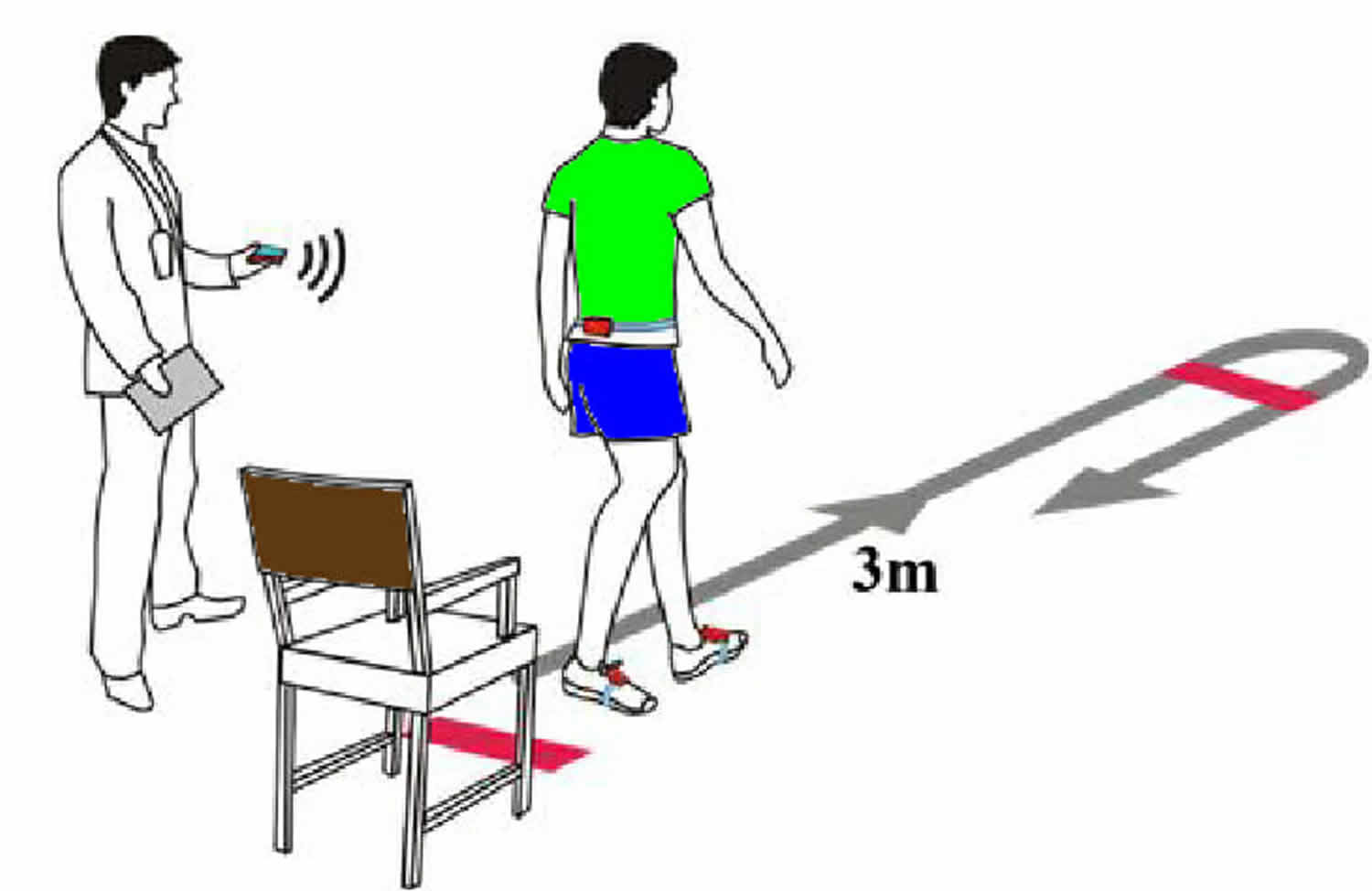Timed up and go test
Timed “Up and Go Test” (TUG) is used to determine fall risk and measure the progress of balance, sit to stand and walking 1. The Timed “Up and Go Test” is the shortest, simplest clinical balance test, and probably the most reliable because it uses agreement in stop-watch durations rather than rating scales 2. The timed up and go test is widely used because of the ease with which it can be performed in the clinic 3. In addition, the timed up and go test has been shown to predict risk of falls in the elderly 4. The timed up and go test duration correlates with severity of moderate-to-severe Parkinson’s disease 5, and is sensitive to therapeutic intervention in Parkinson’s disease subjects 6 but is not sensitive to early Parkinson’s disease 7. Recently, the timed up and go test has been modified to add a secondary task. The timed up and go test cognitive consists of completing the timed up and go test while counting backward from a number between 80 and 100 and the timed up and go test manual consists of completing the timed up and go test while carrying a cup of water 8. A score of 15 seconds on the timed up and go test-cognitive and 14.5 seconds on the timed up and go test-manual is associated with increased risk of falls 8. The clinical success of the timed up and go test is likely related to sequencing of several important mobility skills, such as turning and sit-to-stand transitions that require balance control, as well as straight-ahead gait 9. However, the timed up and go test suffers from the same limitations as the other functional clinical scales, since it is not possible to separate which balance and gait sub-components are affected 7.
Timed up and go test was initially designed for elderly persons, but is used for people with:
- Parkinson’s disease – Timed up and go test is validated for a population with Parkinson’s disease 5.
- Multiple Sclerosis,
- Hip fracture,
- Alzheimers,
- Following a stroke
- Following routine orthopaedic surgery i.e. total knee replacement or total hip replacement
- Huntington disease
- and others conditions
Method of use
A stop-watch is used to measure the duration of functional task performed at a comfortable rate: from sitting in a chair, stand up, walk 3 m, turn around, walk back, and sit down. Participants taking longer than 13.5 to complete the Timed “Up and Go Test” (TUG) are at increased risk for falls. The Timed “Up and Go Test” cut off scores can range from 8 – 11.5 seconds (in populations with Parkinson’s diease looking to identify disability) to 13.5 seconds (older community dwellers) or 15 seconds (if already falling or with dual task).
- The patient starts in a seated position
- The patient stands up upon therapist’s command: walks 3 meters, turns around, walks back to the chair and sits down.
- The time stops when the patient is seated.
- The subject is allowed to use an assistive device. Be sure to document the assistive device used.
NOTE:
A practice trial should be completed before the timed trial
References- Mathias S, Nayak US, Isaacs B. Balance in elderly patients: the “Get-up and go” test. Arch.Phys.Med.Rehabil. 1986;67:387–389.
- Yelnik A, Bonan I. Clinical tools for assessing balance disorders. Neurophysiol.Clin. 2008;38:439–445.
- Weiss A, Herman T, Plotnik M, Brozgol M, Maidan I, Giladi N, Gurevich T, Hausdorff JM. Can an accelerometer enhance the utility of the Timed Up & Go Test when evaluating patients with Parkinson’s disease? Med.Eng Phys. 2009
- Whitney JC, Lord SR, Close JC. Streamlining assessment and intervention in a falls clinic using the Timed Up and Go Test and Physiological Profile Assessments. Age Ageing. 2005;34:567–571.
- Brusse KJ, Zimdars S, Zalewski KR, Steffen TM. Testing functional performance in people with Parkinson disease. Phys.Ther. 2005;85:134–141.
- Auriel E, Hausdorff JM, Herman T, Simon ES, Giladi N. Effects of methylphenidate on cognitive function and gait in patients with Parkinson’s disease: a pilot study. Clin.Neuropharmacol. 2006;29:15–17.
- Zampieri C, Salarian A, Carlson-Kuhta P, Aminian K, Nutt JG, Horak FB. An Instrumented Timed Up and Go Test Characterizes Gait and Postural Transitions in Untreated Parkinson’s Disease. J.Neurol.Neurosurg.Psychiatry. 2010;81:171–6.
- Mancini M, Horak FB. The relevance of clinical balance assessment tools to differentiate balance deficits. Eur J Phys Rehabil Med. 2010;46(2):239–248. https://www.ncbi.nlm.nih.gov/pmc/articles/PMC3033730
- Salarian A, Zampieri C, Horak FB, Carlson-Kuhta P, Nutt JG, Aminian K. Analyzing 180 degrees turns using an inertial system reveals early signs of progression of parkinson’s disease. Conf.Proc.IEEE Eng Med.Biol.Soc. 2009;1:224–227.





